I have returned to last weeks Dark Rye formula with a test bake to determine if the rye flour I am milling is creating havoc with the 100% rye formula.
Two batches of dough were prepared using different flour in each.
For one I used organic wholegrain rye flour from Kialla Pure Foods and for the other I milled organic rye grains from the same company in my Komo Fidibus XL mill.
I didn’t mill the flour quite as finely as previous after reading about starch damage and the issues it can cause with 100% rye breads.
Two separate sours were built using the different flours and then kept at 28C for 18 hours.
The night before, a soaker (the only common ingredient between the two doughs) was prepared containing all the salt, cold water, rye flour and coarsely milled rye grains. This was kept at a 20C for 15hours.
The sours felt quite different when first mixed. The fresh milled sour felt a little drier and I would have been inclined to add water. I didn’t though.
Two sours
[url=http://www.flickr.com/photos/67856223@N06/6275706842/]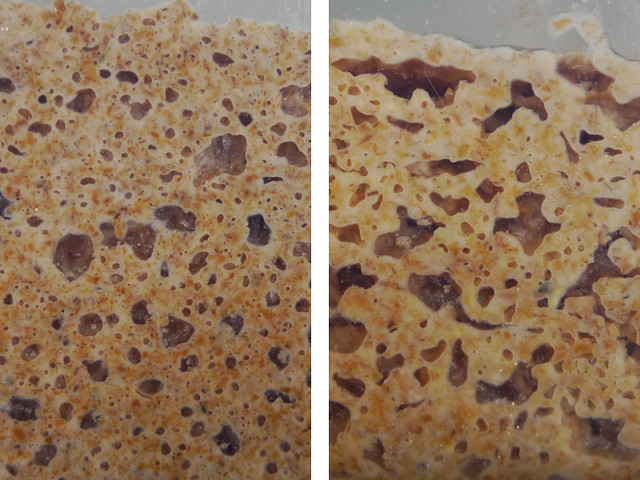 [/url]
[/url]
Bought flour on left, fresh milled sour on right
On the following day I observed that the sour built with store bought flour had risen higher and had an even distribution of bubbling while the home milled sour had not risen as high (it was certainly active) and the bubbling seemed uneven with larger bubbling.
Mixing
[url=http://www.flickr.com/photos/67856223@N06/6275183167/]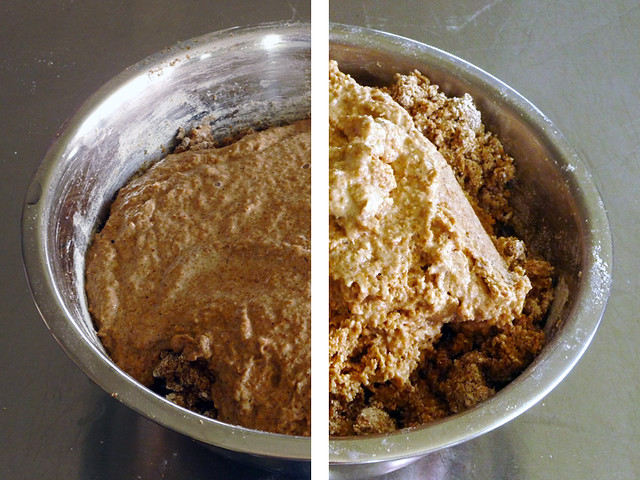 [/url]
[/url]
Incorporating bought flour sour on left, fresh milled sour on right
When it came to add the sours the difference was dramatic. The store bought sour was “poured” out and was extremely runny. I had to spoon out the majority of the fresh milled sour with only a small proportion being runny.
The same temperature water was used in both to achieve common dough temperatures and then placed immediately in greased tins. I did not bother bulk fermenting the dough this time.
Again the fresh milled flour dough felt stiffer and was much easier to handle while the store bought dough proved a challenge to place in the tin in one piece.
Proofing took 1.5 hours with the fresh milled dough rising slightly higher (it may have had to do with hydration of dough)
[url=http://www.flickr.com/photos/67856223@N06/6275441305/]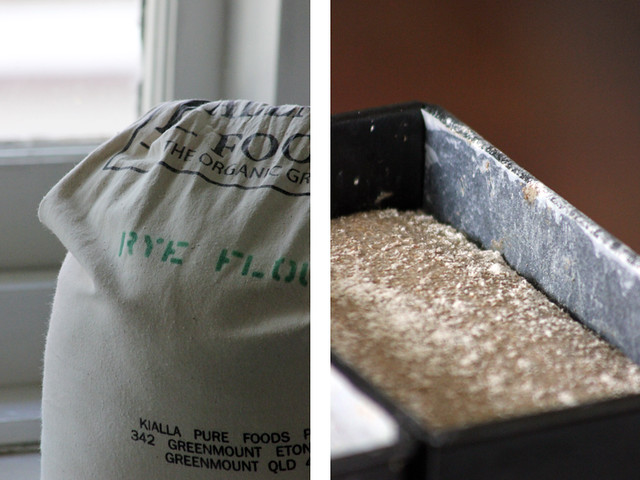 [/url]
[/url]
They were docked and placed in a very hot oven (270C) for ten minutes before being baked for a further two hours at 200C and another hour at 150C. Again the oven was set to auto off and bread cooled in oven for a further two hours.
Breads were wrapped before slicing 36 hours after baking.
[url=http://www.flickr.com/photos/67856223@N06/6275705864/]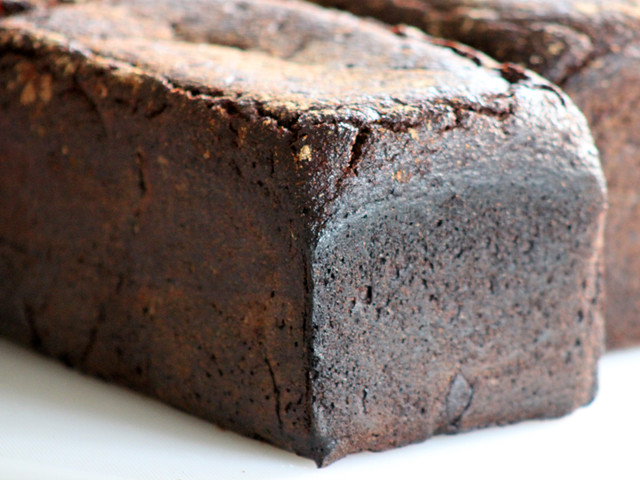 [/url]
[/url]
The first difference came as soon as I cut the breads. The fresh milled bread is a nightmare to cut. Takes a lot of muscle and the cuts are not clean, while the knife easily carves through the bread with store bought flour.
The fresh milled bread has lost its roof again. The other bread is intact, though is showing some signs of separating in some of the corners.
[url=http://www.flickr.com/photos/67856223@N06/6275182989/]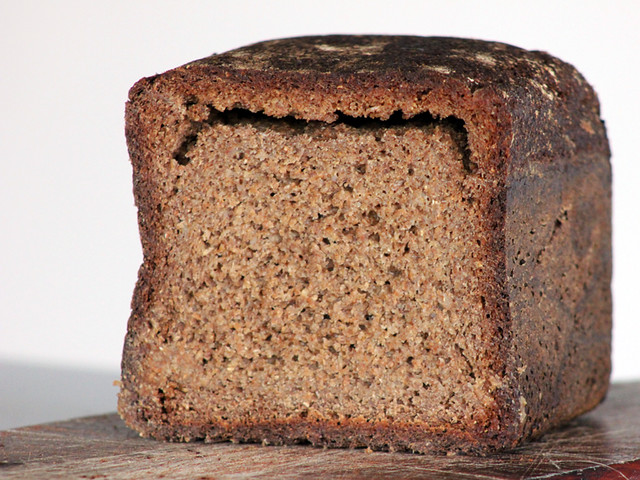 [/url]
[/url]
Fresh milled flour rye having lost its roof
The flavour is quite distinct between the two. The store bought flour bread is not as sour. They both are delicious, but the store bought flour has a nicer mouth feel.
[url=http://www.flickr.com/photos/67856223@N06/6275965200/]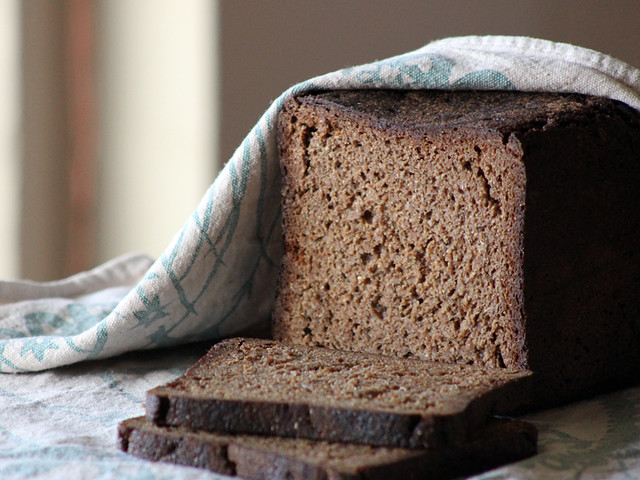 [/url]
[/url]
Bought flour rye
[url=http://www.flickr.com/photos/67856223@N06/6275182591/]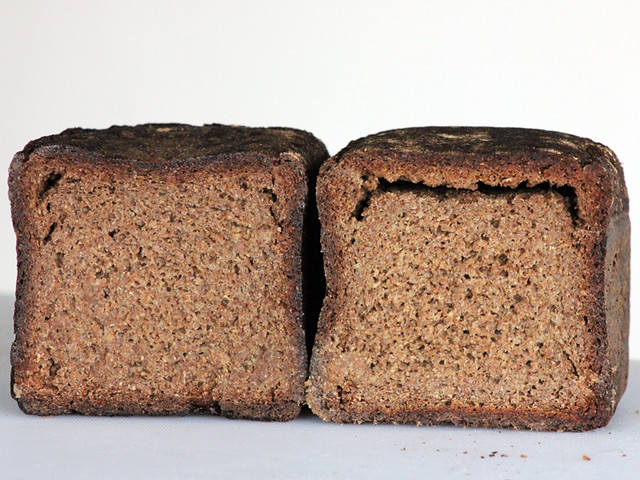 [/url]
[/url]
Side by side
[url=http://www.flickr.com/photos/67856223@N06/6275965378/]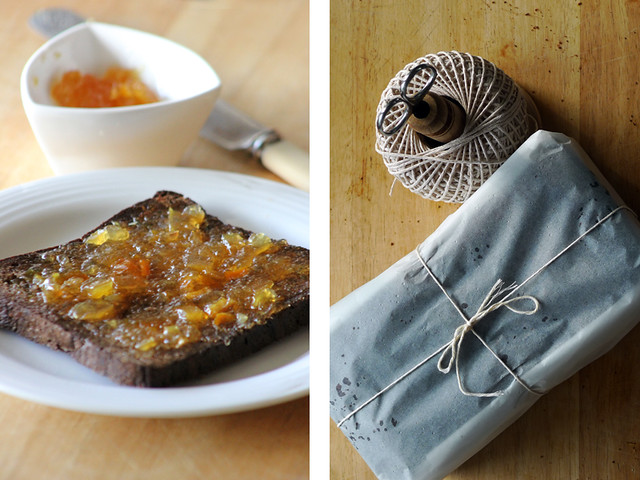 [/url]
[/url]
Breakfast
I have no idea if it is traditional at all, but one of my favourite ways to eat this is with marmalade. We made this marmalade a few months ago using lemons from my tree, grapefruits from my grandfather's tree, oranges from a friend of ours and mandarins from my partners sisters.
Well rye aficionados?...
Would love to get some feedback and advice on this seemingly ongoing project ... problems solved, problems found ...
Cheers, Phil
- PiPs's Blog
- Log in or register to post comments
tell me...
Look at the bubble formation.
One has more rounder bubbles, the other with fresh flour, fermentation has progressed to the point where the bubbles have lost their round shape and have broken protein integrity, broken into one another so that the bubbles are irregular big blobs (loosing the tiny bubbles that make a looser crumb.) The fresh flour starter is telling me that the proof will be a very short as the enzyme level is high, higher than the store bought rye.
Looking down the rest of the photos, nice, what a pleasure to behold. Oops, ok, I would just love to sink my teeth into the crust, ok, on to business. That gummy stripe near the bottom... over-proofed rye! Ouch! Well you could reduce the sour amount/increasing the flour amount or skip any bulk rise and give just a pan rise of 15 minutes. Shaping rye? The paste is not particular (think cement) and I've even spooned the stuff. Just get it into the pan and take wet fingers or a wet spatula to smooth it out. I leave the edges a cm lower than the middle, cover and let it sit (at this stage, as above, just long enough for the newly introduced rye flour to soak up the low pH liquids and start to bond proteins (sort of an autolysis) ... 15 to 20 minutes.) Re-wet the surface, Dock and bake. (Before it over-proofs.)
Mini
mmm ... the bubbles.
When I feed the starter the fresh milled flour it does the same thing even then ... doesn't seem dependent on the amount of time it ferments ... it does it from the moment it starts to rise.
So both are overproofed in your opinion? I was not sure about the store bought one ...
What signs are you looking for when proofing? I am pretty good at judging wheat breads, but this a whole different ball game...sigh.
Cheers, Phil
...from an interested onlooker. Servile, I know, but I have no shame - acknowledgement where it's due (he rises with difficulty on creaking knees, to the crackling accompaniment of crepitus). Seriously, Mini, I find your analysis of rye breads/baking endlessly fascinating.
Good exposé of your ongoing experimentation/advances in rye baking, PiPs. Gives others the opportunity to go along on the ride with you.
Cheers!
Ross
I might even have the rises all screwed up, but my point with the starters (and I wasn't clear) is that the rye is fermenting fast. It is happening much faster than expected. Yes, in both loaves, more in one than the other. So don't let the dough advance as far as the starters have advanced (if you were looking at the starters as if they were the dough. That is one dangerous look for a dough (not so much for a starter.) Somehow fermentation has to be slowed down or controlled. That's all.
I like that word, crepitus. Real goose bump raising! Oh! Was I too blunt? If so, I take it all back. Still like the pictures and layout. The rye will soon come together. Rye has its own mind about how it wants to become bread. Andy? Where are you?
I was just thinking that when I first joined TFL, there were rare rye discussions. This is fun!
it's rare finding a bread without rye, here on TFL. Won't we be spiking the rye consumption (and price!) in the world? :-)
Bring on the bluntness :) Tell it like it is ... a great learning experience.
I present to the world my rye breads, warts and all :)
I am not too concerned with the store bought rye flour ... I just overproofed it. Easy fix. The starter is fermenting nicely and I can easily improve .... and it tastes so good.
A couple of things I am struggling with ...
a) I am getting no feedback with the dough. When I make a wheat bread, there is kneading involved and I can assess the dough. I then stretch and fold and I can assess again. I use roughly three to fours hours of bulk fermenting time. That gives me time to watch, react and adjust if necessary. I feel as if I have none of these luxuries with high proportion rye breads. Mix, bang in a tin and watch with fingers crossed.
b) The flour I am milling. This quote from Andy haunts me a little ...
How do I fix this? Can I fix this? Am I damaging the starch? If the flour is damaged at the time of milling are there ways to stop this or work with the consequences? I have used wheat flour with damaged starch and it was probably the least fun I have ever had baking in my life ... sticky, runny and miserable day.
My starters when fed fresh milled rye always look the same (ugly), no matter the temperature or feeding ratio used. I have used them in wheat breads though and they work fantastically and taste great.
Do I drop hydration? shorten the fermenting time? drop the temperature? Salt? or just decrease the amount of starter used? All of the above? (but you need to develop acid right?) I am keen to try nicodvb's suggestion of vinegar and mini ovens idea of feeding the starter some of the old bread.
I have finished the last bag of rye grains and I am expecting to pick up some more this week.
... uh oh ... rye is again infiltrating my thinking ... eeeek!
Phil,
in eastern europe an old practice is the addition of 2 tablespoons of vinegar to acidify the dough. Once I tried it and I wasn't disappointed (it wasn't perceivable in the baked bread, if you are concerned with excessive sourness). It should help to preserve the integrity of the dough. Why don't you also try to make a shorter bake at very high temperature? Even at 220-250°.
I simply adore rye + marmalade, it's my daily breakfast. A small layer of sourcream between the two makes a wonderful complement!
White vinegar? I might give that a go next time ... think it will be a while though as I have more than enough rye bread now :)
Ooooh yes ... sour cream ... getting excited about breakfast now :)
yes, Phil, always for the same reason: acidity decreases the activity of amylase and preserves the structure of the crumb.
Breakfast is the only exciting moment of the day. Better enjoy it!
Don't forget to save some rye bread for your starter, in fact, feeding the starter altus might help. Why? (I hope I got this right...) Because it has less amylase than the flour but it's still food to the yeasts and the fermenting will not slow down. Crumbled altus gives some structural support so it can't fall as fast. Like crumbling bread in your gravy or onion soup (good place for a rye slice.) It will make it thicker (oh! and with melted cheese) and add some of that crust flavour (bite bite bite) into the inside of the loaf. Altus will also darken the crumb naturally. (I got to go make some soup!)
Mini,
Thanks for this more detailed description of altus and how it acts in dough....I didn't know all of this. Just thought it was a way to use left over bread....One would have thought I would know by now that anything about bread is anything but as simple as it appears to be. :-)
One question that you might be able to answer: Does altus have to be from rye bread to be used in a rye loaf or leaven?
Thanks,
Janet
a good amount of rye. It should be a sourdough. My favorite altus is walnut rye at least 60% rye.
Mini
Thanks for this added info. Mini....next end-of-a -loaf the squirrels and other outdoor critters will have to share with me :-)
Janet
Our Neighbors have combined their field corn this last week, so the neighborhood critters are out in the fields picking up loose kernals. You could put out field corn for them instead. :)
Phil,
Your photography makes any loaf look phenomenal! I am lurking here to see how this 'rye' story develops....please keep posting your findings as I am learning as you do :-)
Take Care,
Janet
Ha Ha, maybe I should photoshop out the gaping hole under the crust :)
I find rye breads really difficult to photograph. Dark little bricks with very little contrast or visual points of interest.
On the other hand I really enjoy eating these dark little bricks with very little contrast or visual points of interest.
All the best
Phil
I feel your frustration and I can't help because I haven't milled my own rye. I am looking into it. By the way, have you read Mini's favorite 100% rye ratio? You may or may not find a discription of rye dough there to help you.
I slowly went thru the first posting, checking on the recipe that inspired you. I went thru the recipe as if doing it myself, my thoughts etc. Then I read thru the post and wondered why you added 2 hours bulk rise? Did I miss something? The inspirational recipe had a bulk rise long enough to drink a sip of water and get back to work shaping. let me see... The soaked grains are kicking out enzymes, the sourdough starter is kicking out enzymes, and the flour amount is small and certainly influenced quickly by all the action and start break down protein bonds as soon as they form. With the 2 hour bulk rise looks to me like a sure case for over-fermenting.
Now I look at the compared study above with two kind of starters telling me that the raw flour (used in the other post and this one) deteriorates (ferments) faster than the older store flour. The bulk ferment for these two loaves are skipped but still are overproved. That means something has to be shortened.
Lets take a look at the soaker. 12 hours. A good night's sleep. Let's not mess with it.
The starter uses 30g for 1300g roughly 100% hydra. expanded starter in 20 hrs. I'm thinking about my starter which works well at 10g per 100g starter for 8-12 hours and then the 100g would make 1000g starter in anouther 12 hours. So my starter of 30g would make a 3000g of ready to go starter in about the same time at maybe 24°C. The recipe makes 1300g starter at 28°C.
If I were to use this recipe I would end up with a very ripe starter. Now since the recipe is overproofed even with store bought, I would reduce the time it takes to make the starter or reduce the temperature of the starter from 28°C to room temp of 24°C. So my suggestion would be, don't put the starter in 28° for 20 hours. Go with 24°C and see how the starter acts.
But we still have to deal with the fresh more active flour. So maybe reducing the temp on the starter is not enough with the fresh flour. I would try it first. Then if it the finished loaf was still overproofing, I'd take half the soaker and heat it up turning it into cooked cereal to work into the dough. If that didn't work, I might make the 12 hour soaker a hot water soaker (got to check on the right temp to use.)
I am hoping Andy will pop in and give his learned wisdom. Meanwhile I go digging into the German rye info on milling...
Mini
Thanks for detailed response Mini. Frustrated yes, but enjoying the challenge in a sick kind of way :) ... and I am learning so much.
Sorry for the confusion. There was no two hour bulk ferment. The first time I made it, I used a 30 min bulk ferment and a two hour proof but this time I mixed, shaped and placed in tins immediately.
I have been having the same thoughts regarding the starter build. Yesterday I was reading (in a very detailed PDF on rye flour - link here) about 1 stage builds and a preferred temperature of 24°C with times roughly matching what you suggested.
A hot soaker is something I have used in the past, but not with this formula. I think I was using roughly 80°C
I am using a hydration of 85%. Maybe I could also look at reducing this also as a way of slowing it down?
I have finished the last bag of rye grains and I am picking up a new bag today. Now I was a little surprised when I picked up the last supply that it was just in a clear plastic bag with a rubberband around the top. I wonder what conditions the grains were in? I have to take it on faith that they were good ...
Looking forward to feeding the starter with fresh flour ... I will use this time to try a few different milling/sifting methods and get the starter looking "pretty" before I start another rye bread.
Thanks again for your time Mini. I really appreciate it
Cheers, Phil
I like the sour I get at 24°C but if your finished loaf is too sour, then it would be better to then keep the 28° C ferment temperature (for a milder sour) and reduce the 20 hours to something more in time with the soaker. Like 12 hours but use 130g (instead of 30g) starter to make 1300g expanded starter. (This is starting to look like a "3 step" with divided parts.) (I couldn't get the link to work.)
I was wondering about the milling. Is it done in one shot? or in steps? First chopped, then middle, and then fine? I know nothing about milling rye. Does it heat up the flour? I can guess at how to make rye flakes... soak the berries and hit 'em with a rock or hammer one at a time... splat and flat! :)
I did find this little gem. Do you temper the grain before milling?
I am not tempering the grains...
From Kialla's website:
This is for wheat:
http://www.thefreshloaf.com/node/16879/home-tempering-and-bolting-wheat-get-high-extraction-flour
Link to Google books Page 581 on tempering and milling rye
Information comes from Food Biochemistry and Food Processing, Edited by Y.H. Hui, Chapter 25 - Rye Constiturents and Their Impact of Pry Processing, authors: T. Verwimp, C.M. Courtin and J.A. Delcour
I found lots of interesting info about rye there.
Mini
I think I have some more information of use...
My order of rye grains did not show. Turns out that the retailer was told that Kialla is not supplying rye grains due to diminished stock after flooding last year.
It seems that the bag of rye I bought and was suspicious of (remember it came in a clear plastic bag with a rubber band around the opening - not the Kialla quality I am used to) was not Kialla grains at all. The bag came from a supplier in sydney and I know nothing about it....mmm....I have read enough about rye to know that it can be pretty variable...mmm....sprout damage?
Anyhow, that bag is finished. I am in the process of sourcing some grains from a reputable biodynamic miller in South Australia....I use their cracked grains and rye meal all the time. I am looking forward to trying again with some of their grains.
Cheers, Phil
Phil, the more the climate is wet the sooner the grains sprout and the higher the enzymatic activity will be. Rye generally has a low falling number, if it rained a lot this number will be even lower and amylase will spike even more. You will need a high level of acidity to counterbalance.
Thats what I am thinking as well. I am keen to try the vinegar addition as well :)
Kialla is now selling imported rye flour which looks nothing like the rye flour they have sold in the past. It is almost white even though they label it as wholegrain. Haven't used any yet.
Think I have some good news...
I finally was able to get a new supply of rye grains yesterday this time from the Wholegrain Milling Company in New South Wales. The first thing I noticed is that visually these new grains look much cleaner and colourful than the last batch. (The last batch being of unknown origin and quality)
So I milled a small proportion and fed it to my rye starter ... instant difference. The batter mixed to a perfect consistency without feeling dry (I was constantly adding water with the old grains) As the starter began to grow I could see that the quality of bubbles was consistent to what have been getting with store bought flour.
This was my starter this morning ... perfect!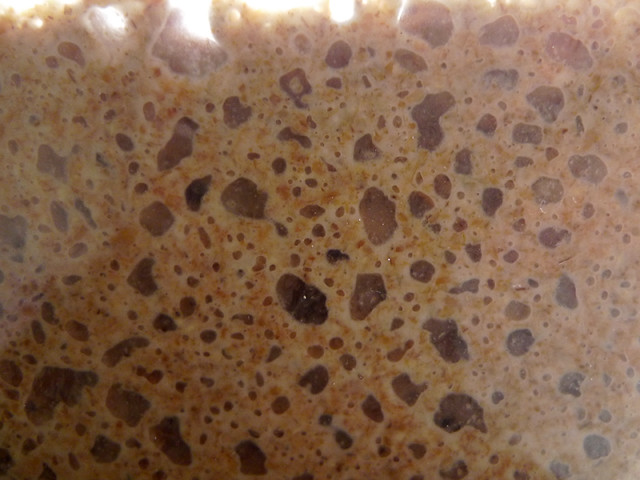 [/url]
[/url]
[url=http://www.flickr.com/photos/67856223@N06/6338195282/]
The image below was the quality that I was getting with the previous grains ... Ugly and dangerous!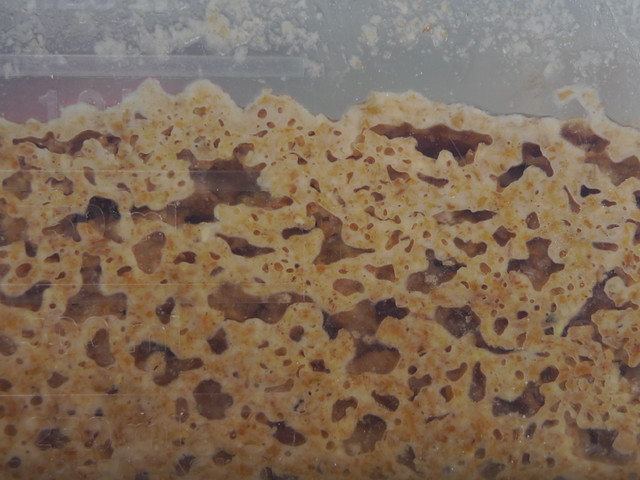 [/url]
[/url]
[url=http://www.flickr.com/photos/67856223@N06/6338230092/]
I feel relieved ... those 5kgs of questionable rye grains nearly drove me insane :) ... I hope to find some time this week to have another attempt at a dark rye.
Feeling a little more confident now...
Cheers, Phil
Hi Phil, Mini et. al.,
Sorry I was on holiday at the time of this post, soaking up sunshine and seeking out authentic local durum flours!!!
Anyway, Mini's analysis of over-rapid fermentation is bang on, and Phil, you found the pertinent remark I made in the past which explains your particular problem.
I wish you every success with the new grain you have found
All good wishes
Andy
One can see that the fermentation is slower it the top picture as in the lower one.